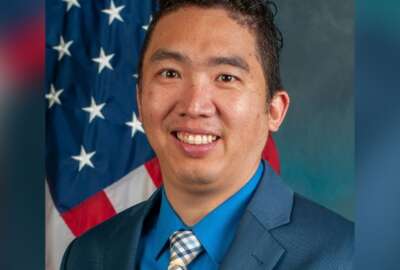Hubbard Radio Washington DC, LLC. All rights reserved. This website is not intended for users located within the European Economic Area.
GAO continues monitoring government’s broader pandemic, delta variant responses
The Government Accountability Office has been regularly reviewing agency COVID response performance. In their latest report, auditors came up with 16 more recom...
Best listening experience is on Chrome, Firefox or Safari. Subscribe to Federal Drive’s daily audio interviews on Apple Podcasts or PodcastOne.
Just when everyone thought it was safe to be normal, the delta variant of COVID-19 emerged. It threw off a lot of plans, including the federal response to the pandemic. The Government Accountability Office has been regularly reviewing agency response performance. In their latest report, auditors came up with 16 more recommendations. For more, Federal Drive with Tom Temin spoke to the GAO’s health care team Director Jessica Farb.
Interview transcript:
Tom Temin: And of course, you have been on this case ever since Congress told GAO, and guess it was the CARES Act, to take regular looks at what is going on. And just review for us what this latest looksee was covering for you.
Jessica Farb: Oh, it covered a range of programs. This is our eighth report comprehensively covering the federal government’s continued efforts to respond to and recover from the pandemic. We had 37 different enclosures as part of our report, looking at things like COVID testing, child nutrition, unemployment, insurance fraud, risk management, the coronavirus state and local fiscal recovery funds, among others.
Tom Temin: And the delta variant, though, really did throw a spike into the work so to speak.
Jessica Farb: I think the biggest issue with the delta variant for the federal government’s response is the uncertainty it has created in a number of these programs, in terms of knowing how much more benefits are going to be needed, or knowing that we need to keep at certain things like testing and ensuring that the testing continues, and that it’s robust. So I think that that’s been the biggest issue with the response in terms of making sure that programs are accounting for this resurgence in cases, as well as sort of planning for some of the uncertainty that will continue well into these winter months.
Tom Temin: I guess the implication here then is that the rate of rise or fall in the daily or weekly cases somehow translates back into demand for government services, and funding for these various channels of response.
Jessica Farb: Exactly. I think for some programs, they have faced issues with needing more guidance on how to implement the program, or how to receive benefits from a program. I think, initially, some of the planning thought that things will be better by the summer. And so some of these programs might not wind down completely, be less than demand, as you say.
Tom Temin: And it’s also complicated by the fact that, since the original CARES Act, back seems like a million years ago, but it was in 2020. Other programs have been overlaid on the response to whether there’s seven or eight different programs for relief from different agencies for different relief purposes.
Jessica Farb: Right. There were several bills passed by Congress to create different relief efforts in areas that they saw as necessary. We’ve looked at all of them under our CARES Act mandates, and some of the programs and some of the funds have been sort of overlapping, but also some of them have been sort of as more funds have been needed, more needs have been identified, created to address those.
Tom Temin: Got it. And the other thing I read in your report, given the number of individual programs, as many of them have not obligated all the original funding to begin with, almost as if too much money has been thrown at the problem, or at least appropriated for the problem.
Jessica Farb: That’s correct. I think Congress has asked GAO and really expects us to help them with oversight of how much has been disbursed and obligated and expended, and we are tracking that in our work across the various programs and departments. And in some cases, there’s a little bit of a lag in the data. So we’re working closely with Treasury to try to understand where those differences and obligations and expenditures exist and reporting that out to Congress. So for example, in total, there’s been over $4.7 trillion appropriated, and expenditures have only been at almost 3.4 trillion so far. So there’s another over trillion dollars that has still to be expended. But we’re, as I said, working closely with Treasury to track those funds.
Tom Temin: In other words, there’s enough left over at this point to equal the entire infrastructure bill. Just as a point of reference, that’s all.
Jessica Farb: I guess that’s an interesting way to look at a time, yes. Now, when you talk to some of the agencies, they may say, well we know that there will be additional spending that is going to occur. A lot of these funds can be extended through 2025. So they’re not one year monies, they’re multiple year monies. And that’s sort of, I think, not unheard of with disasters or pandemics in terms of needing time for the funds to reach the neediest recipients, as well as making sure that the oversight of those funds is being done correctly.
Tom Temin: We’re speaking with Jessica Farb. She’s a director on the health care team at the Government Accountability Office. And just review briefly give us a sense of the overview, if you will, of the many recommendations that you had made to the various agencies before this latest report.
Jessica Farb: Oh, yeah, I think those recommendations have — we’ve made 195 prior to this report — and those have covered over 14 agencies that have been dealing with public health response, service delivery, the economy and program integrity activities. The agency have partially or fully implemented about 1/3 of those recommendations so far. An example of one that has been agreed with and has started to be implemented is we recommended that the Center for Disease Control and Prevention, or the CDC, take steps to be able to comprehensively assess the long term effects of COVID-19 on persons across the nation, but also, in particular, certain races and ethnicity. And we did that because preliminary research suggests that these long term health effects can include heart, brain and lung abnormalities. And CDC has agreed with our recommendation and started to collect data to do that kind of assessment and analysis.
Tom Temin: Yeah, so there’s about 60 some recommendations yet to be implemented. And then in the latest report, you have piled on a little bit with, if I count 16 new recommendations. And generally what types of things do those cover?
Jessica Farb: Those covers things like oversight of fraud risk, making clear how beneficiaries can access relief funds, making sure we’re using consistent policies in terms of rewarding those funds, things like looking at Child Nutrition Programs and duplication, there is a wide range of issues that are covered. One example is for the Provider Relief Fund, which was intended to provide funds to keep medical practices and medical facilities open during the pandemic, when a lot of the elective care was being postponed. We found that a large amount of that fund had been allocated, but not yet dispersed. And there were still some that had been unallocated, but the agency that’s supposed to oversee these funds hadn’t been doing a lot of post payment reviews of the payments that they made to make sure that they weren’t going to the wrong entities.
Tom Temin: Alright. And there’s a lot of programs, as we mentioned, here. There’s a relief for health care providers, there’s the state and local fiscal recovery funds, there’s unemployment insurance, there’s FEMA disaster relief directly related to the pandemic, there’s loans for aviation, and other types of programs, in addition to the small business loans and so forth. I guess most of that has been played out. Overall, I mean, what’s your sense of the government’s ability to deliver these programs with some degree of integrity on a scale of A through F at this point?
Jessica Farb: Ooh. I think we think they’re doing, we’re still finding some areas as obviously with 16 new recommendations where there can be improvements. Often there’s something in place, but we’re finding that there may be a lack of information or lack of clarity, or lack of consistency in some of the oversights. And I think, across the board, it’s hard to give one score, given the size and scope of all of these programs. But some of the work that we’ve done reflects previous work, prior to the pandemic, where we’ve noted concerns about programs and oversight of these programs. And some of these agencies were thrown kind of into into an oversight function that they weren’t typically performing in the past as part of their normal operations. For example, when I mentioned the Provider Relief Fund, the Health Resources and Services Administration is the entity that’s implementing that program, but they typically are not a large entity in terms of putting out that type of funding, that usually falls to an agency like the Center for Medicare and Medicaid Services, and they have a lot of oversight built into their activities because of the nature of what they do and the size of the programs that they manage.
Tom Temin: Yes, they’re used to trying to ferret out waste, fraud and abuse because programs they operate are kind of the biggest improper payers. So eight reports to go so far by GAO. What’s the prognosis? How long does this oversight role related to the pandemic go on for GAO?
Jessica Farb: Well, we are currently working with our congressional oversight clients and talking to them about additional reports. We right now will be reporting again in January and April, and plan to report beyond that. As I said earlier, the funds go through 2025, sSo there’s a need for oversight that continues till those funds are fully expended. And we can provide Congress with the information that they need to know how well everything was handled and how we’ll spend, and what lessons can be learned from all of this.
Tom Temin: So you won’t retire on this work, but you could come close.
Jessica Farb: Well, hopefully no, I’ve still got a few more years of federal service left. So no, I won’t be retiring on this work. But I do think it’s important work that we will continue to do. We haven’t determined yet how we will continue our reporting. In addition to the eight comprehensive reports that you mentioned, we’ve also reported over 120 Other reports that are specific aspects of the federal response. We’ve testified on these issues. And we’ve also released what we call science and technology spotlights, so focusing on really specific aspects of the science angle to the pandemic and the response and recovery.
Copyright © 2024 Federal News Network. All rights reserved. This website is not intended for users located within the European Economic Area.
Tom Temin
Tom Temin is host of the Federal Drive and has been providing insight on federal technology and management issues for more than 30 years.
Follow @tteminWFED





